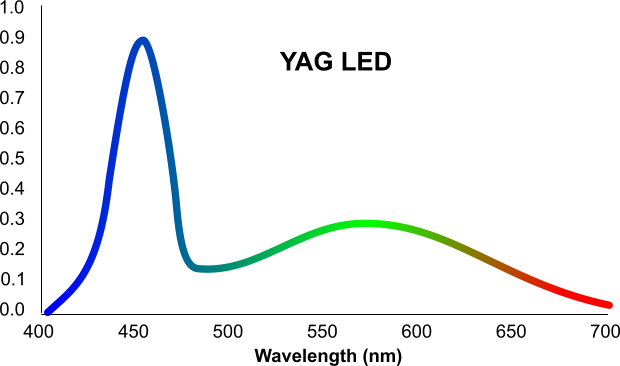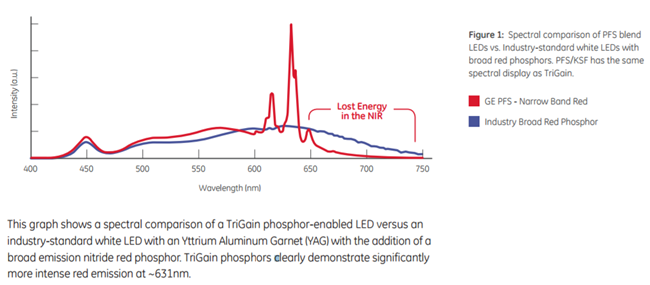One of the interesting topics that has developed over the last couple of years has been the development of wider colour gamut (WCG) LCDs. We’ve reported a lot on the QD approach, but QDs, relatively, cost quite a lot and a number of alternatives have been developed to improve the gamut, but at lower cost.

When LED backlights were first developed, it was expected that, after a while, RGB LEDs would be used to create the backlights for LCDs, as the LEDs could then be tuned to work well with filters and give high colour gamuts and good efficiency. In fact, companies such as NEC, Eizo and Sony developed high end TVs and monitors using that approach, but the products didn’t last long in the market. It turned out that the issues of LED control and selection were just too difficult. LEDs vary in their colour and brightness output, they change their output according to age, driving and temperature and proved just too tricky to engineer. Further, green LEDs are hard to make with high efficiency. A paper from the the OSA has some background on this.
As a result, the vast majority of LED-backlit displays used ‘White LEDs’. These are not LED devices that produce white light, but blue LEDs with some kind of colour conversion of some of the light to red and green. That’s the same approach as used in current quantum dot solutions, but QDs are too sensitive to heat to be placed on the LED chip, currently, so phosphors have been used.
YAG is the Mainstream
The main phosphor used is YAG (Yttrium Aluminum Garnet) which produces yellow light from the blue source. Yellow, of course, is composed of red and green light, so with one phosphor, you can cover all three primaries. It’s an elegant solution that is, relatively, low cost and Nichia holds patents for this kind of LED (and vigorously enforces its patent, as we have reported in our subscription newsletters). Sadly, there is a downside. The spectrum of the light from YAG is very ‘muddy’ – it contains a wide spread of different wavelengths. That makes it difficult to create the pure reds and greens needed for the wider colour gamuts, such as AdobeRGB and DCI-P3.
As reported in a paper at last year’s SID by Sharp Research (Content Adaptive Expandable Colour Gamut LCD), the efficiency advantages of YAG, even when a lot of the light is then filtered away, are so strong that the architecture is very attractive.
 YAG is efficient, but has a very broad range of colours in the green to red range.
YAG is efficient, but has a very broad range of colours in the green to red range.
Can You Improve YAG?
One way to improve the performance of YAG LEDs would be to improve the ‘peakiness’ of the spectrum by filtering out the colours between the red and green primaries. At CES, LG made a lot of noise about its Nano Cell technology which improves the gamut. The technology, at least in its Nano Cell 1 form, is a film that perfoms this filtering function. Samsung has also had this kind of technology in some of its TV panels to boost colour gamuts.
More LEDs?
One way to solve the challenges of the wide spectrum of YAG is to use two different LEDs and LCD makers developed backlights based on a combination of blue and green LED chips, with a phosphor to create the red. (GB-R). Alternative approaches included using blue and red LEDs with green phosphor (BR-G). However, using two LED chip sources introduces some of the complications of the RGB LED approach and is also, relatively, expensive.
What About More Phosphors?
Another way to boost gamut is to use two separate phosphors to perform the red and green conversion from the blue LED, with the resulting light being much more ‘pure’ than the YAG white light. That has been tried a number of times, but the red phosphors tended to be quite broadband, so need quite a lot of filtering. Back in 2015, in data presented at a Korean conference, IHS estimated that using red and green phosphors cost around 3% overall more than YAG-based solutions.

In 2014, GE presented a paper at the SID explaining new phosphors that it has developed (PFS Potassium Fluoride Silicon and PFT) and which others call KSF (based on the formula K2SiF6:Mn4+) and which offer a narrow emission spectrum red that really helps with WCGs. GE has licensed the technology to companies including Suijing Optoelectronics and Foshan Nationstar in China, for use in WCG backlights.
 Trigain spectrum – Image:GE
Trigain spectrum – Image:GE
GE has a downloadable paper on this TriGain technology.
There are not many disadvantages of KSF, but one that we have seen identified as a drawback compared to QDs and other approaches is that the decay time of KSF is long, which means that special features such as high frame rate or active 3D are not possible.
It Always Comes Down to Price….
Thanks to our friends at IHS Markit, we found that the cost of an LCD TV using direct backlighting and a KSF-based LED backlight is actually around 6% cheaper than an edge-lit panel, but it can have a wider colour gamut. In contrast, a panel with QDs costs 11% more than the edge-lit panel. In the world of TV, that’s compelling.
As a result, we have seen KSF adoption move down from brands such as Sony last year to very mainstream and economy brands of TVs this year at CES. Bob Raikes

